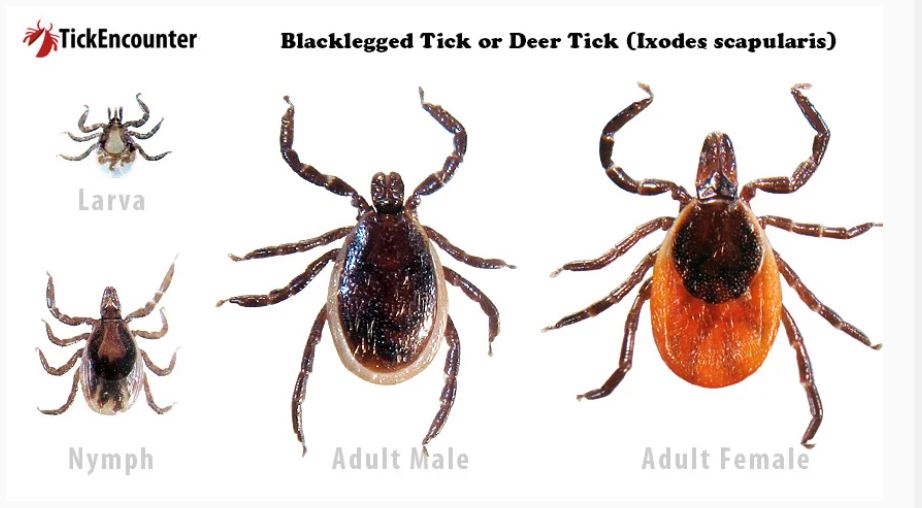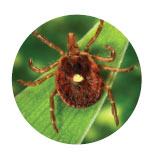It is spring and the prime season for ticks. These little creatures can be intimidating and scary. They have the power to dampen what could be a fun hiking or camping trip.
But the reality is, we need to learn to co-exist with them because they aren’t going anywhere. To do that, it is important to educate yourself on them and what the best ways are to protect yourself from them.
Ticks Found in Michigan
Michigan has two common ticks that most people will encounter, one that is currently not common but is continuing to expand its range, and two less common species that are unlikely to be encountered. It is a good idea to understand where these ticks can be found and to properly identify them so that when you do encounter them, you can be prepared with what actionable steps you need to take.
American Dog Tick

Where & When to Find the American Dog Tick
Found mostly along forest edges and in areas with little or no tree cover. This tick has become a common backyard find here in Michigan. It tends to be active from April to early August.
Hosts & Feeding
As a larvae and nymph, the American Dog Tick mainly feeds on small mammals, such as voles, mice, rats, and chipmunks. The adult stage prefers medium-sized hosts, like raccoons, skunks, cats, dogs, and humans.
The female American Dog Tick will feed on a host for one week or more before becoming engorged. The male will feed for a day or two without becoming engorged. He then detaches from the host and goes on a search to find a female to mate with.
Once the female is engorged, she leaves the host, lay around 2,000 eggs, and die.
Diseases
The American Dog Tick rarely transmits diseases in Michigan. However, it does have the potential for carrying Rocky Mountain spotted fever and Tularemia.
A few years ago, this was the most common tick that I would find. However, over the last two years especially, there has been a shift from American Dog Ticks to the Black Legged Tick.
Blacklegged Tick

Where & When to Find the Blacklegged Tick
The Blacklegged Tick is becoming more predominately found throughout the entire state. It is typically active from October to May, as long as the daytime temperature is above freezing.
It performs something called “questing” to find its prey. Questing is essentially a technique where the tick is able to track high-trafficked areas on a trail. It will then sit on a branch or plant at about knee height and wait with its legs stretched out for something to walk by that it can grab.
Hosts & Feeding
Nymphs and adults can both feed on humans and both can transmit diseases. The nymphs are so small that they are easily missed during tick checks.
The adult female prefers larger hosts such as deer and humans. It takes about four days for an adult female to fully engorge. She will then drop off and over-winter, preferably in leaf litter. In mid to late May, she will lay up to 2,000 eggs before dying.
Diseases
The Blacklegged Tick can transmit multiple diseases, the most widely known being Lyme Disease. This is the only tick that carries Lyme Disease. Other disease (but rare in Michigan) are deer tick virus, hard tick relapsing fever, human analpasmosis, human babesiosis, and powassan virus.
Lone Star Tick

Where & When to Find the Lone Star Tick
While not commonly found within the state of Michigan, it is making an appearance. It prefers woodlands with dense undergrowth and is most active from April to late August.
I have only encountered it once.
Host & Feeding
This is an aggressive biter that will go for pretty much anything. They do go questing, similar to the Blacklegged Tick, and look primarily for larger animals such as dogs, coyotes, deer, cattle, and humans.
The female is easily identified by the single white spot on her back. Once she has a host, it takes her a week to 10 days to become fully engorged. She will then lay around 3,000 eggs prior to dying.
Diseases
The Lone Star Tick can carry and transmit Ehrlichiosis, Rocky Mountain spotted fever, and Tularemia.
Uncommon Ticks
There are two uncommon ticks that it is highly unlikely that you will encounter. The Woodchuck Tick and the Brown Dog Tick.
The Woodchuck Tick is commonly found on pets because it resides typically around Woodchucks – hence the name. It typically will stay near the den of a Woodchuck and isn’t frequently encountered. It does have the ability to transmit Powassan encephalitis.
The Brown Dog Tick is a unique type of tick that thrives in indoor environments. It can be found in kennels, shelters, and breeding facilities where conditions aren’t kept clean. Good hygiene practices can prevent this tick from taking up residence. It does have the potential to transmit Rocky Mountain spotted fever, Canine Babesiosis, and Canine ehrlichiosis.
What You Should Know About Ticks

Ticks don’t fly, they crawl up. Ticks typically start from the ground and climb up their host. The goal is to reach the head and neck area because the tissues are softer, thinner, and easier to burrow through.
Tip – Wear tall socks and tuck your pant legs into your socks. Ticks will have to climb on the outside of your clothing and can be spotted more easily. You can also spray your shoes and socks with a 20% deet to deter them from even beginning a climb.
Ticks have three active stages. Ticks hatch from an egg and then undergo three life stages. Larvae, nymph, and adult. In each stage, the tick is a different size, can be found in different locations, and can follow different behavior patterns. Larvae are about the size of a grain of sand and don’t feed on human hosts. Nymphs are about the size of a poppy seed and can feed on humans. Adults are about the size of an apple seed.
Ticks can be active any time of year. If the temperature during the day is above freezing, it is possible to encounter ticks. It is important to be vigilant during any time of year. I personally have found ticks even in February.
A 24-Hour Bite Window. In most cases, when a tick attaches to a host, the host has a 24-hour window to find and safely remove the tick prior to a disease being transmitted. That means doing a daily tick check when you have been in area that you know has ticks (even if it is your backyard), is extremely beneficial.
Pointy Tweezers for Tick Removal. If you find a tick that has attached, the best method of removal is using pointy tweezers. If you squeeze too hard on the back-end of the tick, you will push the germs of the tick forward and potentially infect yourself. Using pointy tweezers, you can get near the mouth of the tick and pull it out like you would a splinter.
Tip – If you can’t properly identify the tick or don’t know how long it has been attached, you should save the tick and get it identified and tested, just to be sure.
Clothing with built-in tick-repellent. Did you know you can get clothing with permethrin tick repellent built in? While there is some controversy with the overall safety of permethrin for people and the environment, this particular chemical is extremely effective at protecting from and preventing tick bites. You can also treat your own clothing with a spray.
Tip – Treating your clothing rather than your skin is a safer route to go. No matter what option you go with, treating your clothing provides you with an extra layer of protection between you and the ticks as well as the chemicals and your own system.
Tick bites and tick bourne diseases are preventable. There are multiple ways that you can practice different prevention techniques to avoid getting bit by a tick. Not all of these options work for everyone but there is an option for everyone. It all starts with education.
Prevention
There are several options for the prevention of tick bites. Along with wearing treated clothing, you can spray your clothes with insect repellent prior to going outside. The CDC recommends that you use a repellent with one of the following ingredients.
- Deet (up to 20%)
- Picaridin
- IR3535
- Oil of Lemon Eucalyptus
- Para-menthane-diol
- 2-undecanone
Whether you doing a day hike, a camping trip, or yard work, you should always do a check at the end of the day. Check your clothes and body for any ticks that may have hitched a ride. I try to do this prior to coming indoors to avoid bringing any ticks into the house or tent.
Examine your gear and your pets the same way you check yourself. Ticks tend to like to hide in places so I always check my shoes thoroughly as well.
When I come home from a hike or a trip, I throw all of the clothes into the dryer. Heat can help kill any ticks that you may have missed in your clothing.
If possible, take a shower. This makes it easier to do a full body check but also can help wash off any unattached ticks that might be lurking.
Education is key in prevention. Understanding how ticks function and how you can prevent them will give you the best opportunity to stay safe and enjoy the outdoors.
For more information, visit TickEncounter.

Leave a Reply